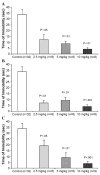Antidepressant-like effects of neurokinin receptor antagonists in the forced swim test in the rat
- PMID: 15659299
- PMCID: PMC5127697
- DOI: 10.1016/j.ejphar.2004.11.024
Antidepressant-like effects of neurokinin receptor antagonists in the forced swim test in the rat
Abstract
Although a wide assortment of agents is currently available for the treatment of depression, this disorder remains poorly managed in a large proportion of patients. Traditional antidepressant treatments target the biogenic amine systems. However, a growing body of evidence is implicating the involvement of neuropeptides in depression, especially the neurokinin substance P. This study evaluated the effects of selective antagonists of the tachykinin NK1, NK2, and NK3 receptors in the forced swim test, a commonly used screen for antidepressants. Rats were given CP-96,345 (2S, 3S)-cis-2-(diphenylmethyl)-N-[(2-methoxyphenyl)-methyl]-1-azabicyclo[2.2.2]octan-3-amine, SR 48968 (S)-N-methyl-N[4-(4-acetylamino-4-phenylpiperidino)-2-(3,4-dichlorophenyl)-butyl]benzamide, or SR 142801 (S)-(N)-(1-(3-(1-benzoyl-3-(3,4-dichlorophenyl) piperidin-3-yl) propyl)-4-phenylpiperidin-4-yl)-N-methylacetamide, antagonists of the NK1, NK2, and NK3 receptors, respectively, at doses of 2.5, 5, and 10 mg/kg, intraperitoneally (i.p.). The time of immobility during the forced swim test was used as an indicator of antidepressant activity of the antagonists. All antagonists decreased immobility times. CP-96,345 and SR 142801 showed dose-related effects; SR 48968 had its maximum effect at 2.5 mg/kg. The magnitude of the effects of the neurokinin receptor antagonists was approximately the same as that of amitriptyline and desipramine, two traditional antidepressants, both given at 10 mg/kg, i.p. This study provides comparative data on the relative effectiveness of NK1, NK2, and NK3 receptor antagonists in this screen for antidepressant drug activity.
Figures


Similar articles
-
Effect of tachykinin receptor antagonists in experimental neuropathic pain.Eur J Pharmacol. 1998 Nov 20;361(2-3):175-84. doi: 10.1016/s0014-2999(98)00722-5. Eur J Pharmacol. 1998. PMID: 9865506
-
Characterization of tachykinin receptors in the uterus of the oestrogen-primed rat.Br J Pharmacol. 1998 Jan;123(2):259-68. doi: 10.1038/sj.bjp.0701613. Br J Pharmacol. 1998. PMID: 9489614 Free PMC article.
-
Effects of tachykinin receptor antagonists on the rat jejunal distension pain response.Eur J Pharmacol. 1998 Mar 26;345(3):247-52. doi: 10.1016/s0014-2999(98)00040-5. Eur J Pharmacol. 1998. PMID: 9592022
-
(2S,3S)-N-[[2-[11C]Methoxy-5-[5-(trifluoromethyl)tetrazol-1-yl]phenyl]methyl]-2-phenyl-piperidin-3-amine.2006 Jul 19 [updated 2008 Apr 3]. In: Molecular Imaging and Contrast Agent Database (MICAD) [Internet]. Bethesda (MD): National Center for Biotechnology Information (US); 2004–2013. 2006 Jul 19 [updated 2008 Apr 3]. In: Molecular Imaging and Contrast Agent Database (MICAD) [Internet]. Bethesda (MD): National Center for Biotechnology Information (US); 2004–2013. PMID: 20641902 Free Books & Documents. Review.
-
Neurokinin-receptor antagonists: pharmacological tools and therapeutic drugs.Can J Physiol Pharmacol. 1997 Jun;75(6):612-21. doi: 10.1139/cjpp-75-6-612. Can J Physiol Pharmacol. 1997. PMID: 9276138 Review.
Cited by
-
New therapeutic targets for mood disorders.ScientificWorldJournal. 2010 Apr 13;10:713-26. doi: 10.1100/tsw.2010.65. ScientificWorldJournal. 2010. PMID: 20419280 Free PMC article. Review.
-
Proof of concept trials in bipolar disorder and major depressive disorder: a translational perspective in the search for improved treatments.Depress Anxiety. 2011 Apr;28(4):267-81. doi: 10.1002/da.20800. Epub 2011 Feb 24. Depress Anxiety. 2011. PMID: 21456037 Free PMC article. Review.
-
Early life stress differentially modulates distinct forms of brain plasticity in young and adult mice.PLoS One. 2012;7(10):e46004. doi: 10.1371/journal.pone.0046004. Epub 2012 Oct 5. PLoS One. 2012. PMID: 23071534 Free PMC article.
-
Serotonin transporters: implications for antidepressant drug development.AAPS J. 2005 Oct 5;7(2):E421-33. doi: 10.1208/aapsj070242. AAPS J. 2005. PMID: 16353921 Free PMC article. Review.
-
Short-term NK1 receptor antagonism and emotional processing in healthy volunteers.Psychopharmacology (Berl). 2011 May;215(2):239-46. doi: 10.1007/s00213-010-2133-z. Epub 2010 Dec 15. Psychopharmacology (Berl). 2011. PMID: 21161182 Clinical Trial.
References
-
- Baby S, Nguyen M, Tran D, Raffa RB. Substance P antagonists: the next breakthrough in treating depression? J Clin Pharm Ther. 1999;24:461–469. - PubMed
-
- Backman SB, Henry JL. Effect of substance P and thyrotropin-releasing hormone on sympathetic preganglionic neurones in the upper thoracic intermediolateral nucleus of the cat. Can J Physiol Pharm. 1984;62:248–251. - PubMed
-
- Bondy B, Baghai TC, Minov C, Schule C, Schwarz MJ, Zwanzger P, Rupprecht R, Moller H. Substance P serum levels are increased in major depression: preliminary results. Biol Psychiatry. 2003;53:538–542. - PubMed
-
- Borsini F, Meli A. Is the forced swimming test a suitable model for revealing antidepressant activity? Psychopharmacology. 1988;94:147–160. - PubMed
-
- Brodin E, Rosen A, Schott E, Brodin K. Effects of sequential removal of rats from a group cage, and of individual housing of rats, on substance P, cholecystokinin and somatostatin levels in the periaqueductal grey and limbic regions. Neuropeptides. 1994;26:253–260. - PubMed
Publication types
MeSH terms
Substances
Grants and funding
LinkOut - more resources
Full Text Sources
Other Literature Sources
Medical
Research Materials
Miscellaneous

